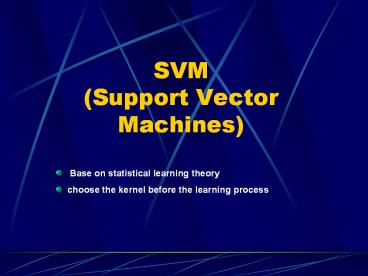SVM%20(Support%20Vector%20Machines) - PowerPoint PPT Presentation
Title:
SVM%20(Support%20Vector%20Machines)
Description:
The support vector algorithm simply looks ... and the training was repeated, the same separating hyper plane would be found. ... w is the normal of hyper-plane ... – PowerPoint PPT presentation
Number of Views:301
Avg rating:3.0/5.0
Title: SVM%20(Support%20Vector%20Machines)
1
SVM (Support Vector Machines)
- Base on statistical learning theory
- choose the kernel before the learning process
2
Recent applications of SVM
- Pattern recognition
- Isolated handwritten digit recognition
- Object recognition
- Speaker identification
- Regression estimation
3
Idea of SVM in Pattern Classification
- The support vector algorithm simply looks for
largest margin. - d (d-) is the shortest distance from the
separating plane to the closest positive
(negative) point. - ( d d- )
- Margin equal to d plus d-
4
- For these machines , the support vectors are the
critical elements of the training set. If other
training points are removed, and the training was
repeated, the same separating hyper plane would
be found.
5
A general two-class pattern classification
problem
- sample point (x1,y1) , (x2,y2) .. (xi , yi)
- X is the vector of the point
- Y is the class label
- For example, in two-class pattern classification
- Y 1 , -1
- Find a classifier with the decision function
- f(x) such that y f(x)
6
Linear Support Vector Machine
- w is the normal of hyper-plane
- b / w is the perpendicular distance from
the hyper-plane to the origin
decision function is f(x) wx b 0 Notice
that there is ambiguity in the magnitude of w and
b. They can be arbitrary scaled such that H1
xw b 1 , H2 xw b -1 d d- 1/ /
w , so , margin d d- 2/ w This
optimization problem is solved using the
Lagrangian formulation.
7
decision function
- Simple dot product
- Polynomial
- Radius base function
8
Demo
http//svm.dcs.rhbnc.ac.uk/pagesnew/GPat.shtml
9
Dont understand !
- According to the Empirical Risk Minimisation
algorithm, the classifier with the largest margin
will give lower expected risk, i.e. better
generalisation - VC dimension































